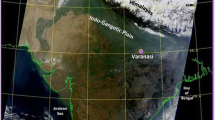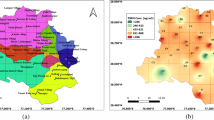Abstract
Total suspended particulate samples (TSP) were collected and concentrations measured during seventeen months in the vicinity of a ceramic industrial area. A method of fractionating was applied to the samples in order to obtain two fractions corresponding to mineral particulate coming from dust emissions (Upper-F fraction) and to amorphous matter (carbon plus small amounts of S, Ca, Fe, etc) coming mainly from traffic and other combustion processes. Also for TSP samples several element concentrations were measured following two previous treatments: extraction of elements mainly associated with the soluble fraction of the samples (B, Fe, P, As, NO2−, NH4+, Cl−, F) and acid digestion for trace metals and elements mainly associated with the non-soluble fractions of the samples (Fe, As, Cd, Ni, Pb, Zn Ca). Seasonal differences and the influence of meteorological parameters (temperature, relative humidity, pressure and wind conditions) on the air pollution levels, particles as well as ions, were studied.
Results show different seasonal and weekly evolution for mineral and amorphous carbonaceous particles because of the different origins in dust emissions or combustion processes respectively, and the different physical properties such as size grain. Of the ions analyzed Fe, Ca and Zn were clearly associated to mineral phases and consequently related to dust emissions, and NO2−, NH4+, P, Cl− were related to amorphous matter coming from combustion. Ni and Cd show lower levels than those reported as guideline values and the source is mainly related to the enrichment of these elements in clay materials. B and As content result in elevated concentrations, with the tendency to increase during cold months. The emission of these elements was associated with vaporization or volatilization during high temperature ceramic processes. The original gaseous state is influenced by temperature. In the winter the content for B and As is higher due to enhanced condensation of gas-phase boron onto particles, while in the summer the increase of air temperature results in elevated evaporation.






Similar content being viewed by others
References
Alvarez C, Jordán MM, Boix A, Gómez ET, Sanfeliu T (1999) Non-crystalline nature spherical particles as possible tracers of emissions of the ceramics industry. In: Brebbia CA, Jacopson M, Power H (eds) Air pollution VII, vol 1, Proc 7th Int Conf Air Pollution. WITPress, Boston, pp 385–393
Anderson L, Kitto E, McCarthy M, Zoller H (1994) Sources and atmospheric distribution of particulate and gas-phase boron. Atmos Environ 28(8):1401–1410
Bergametti G, Dutot AL, Buat-Menard P, Losno R (1989) Seasonal variability of the elemental composition of atmospheric aerosol particles over the Northwestern Mediterranean. Tell Us 41B: 353–361
Boix A (1995) Modelización del proceso de la dinámica mineral en la atmósfera de Castellón. Phd Thesis, Universitat Jaume I, Castellón, Spain
Boix A (1996) Contaminación atmosférica en la Plana de Castellón. Exc. Ajuntament de Castelló de la Plana. Graphic Group, S.A. Castellón
Boix A, Mateu J, Jordán MM, Sanfeliu T (1995). A statistical analysis applied to a study of atmospheric pollution by SO2 and particles in the conurbation of Castellón and its relation to local meteorological parameters. In: Brebbia CA, Jacopson M (eds) 3rd Int Conf Air Pollution. WITPress, Boston
Bretschneider B, Kurfust J (1987) Air pollution control technology. Elservier, Amsterdam
Busani G, Navarro JE (1994) Contaminación atmosférica e hídrica. Cerámica Información 225: 23–46
Clarke AG, Azadi-Boogar GA, Andrews GE (1999) Particle size and chemical composition of urban aerosols. Sci Total Environ 235:15–24
Gómez ET (2002) Aplicación de métodos cristalográficos (DRX en polvo cristalino) y geoquímicos al estudio de la dinámica mineral en contaminantes atmosféricos particulados. Phd Thesis, Universitat Jaume I, Castellón de la Plana, Spain
Gómez ET, Rius J, Sanfeliu T (2002) A standardless X-ray diffraction method for the quantitative analysis of multiphase mixtures: II application to non-infinitely thick samples. J Appl Crystallogr 35(5):600–605
Gómez ET, Sanfeliu T, Rius J, Vicente AB (2001). Physical and mineralogical characteristics of the atmospheric aerosol in an area near industrial activity based on mineral raw materials. In: Latini G, Brebbia CA (eds) Air pollution IX, vol 1, Proc 9th Int Conf Air Pollution. WITPress, Boston, pp 619–627
Hrsak J, Sisovic A, Skrbec A, Sega K (2001) Seasonal differences in the levels of suspended particulate matter and heavy metals in the vicinity of a waste dump. Atmos Environ 35:3543–3546
Jordan MM, Alvarez C, Sanfeliu T (2002) A powder diffraction quantification method (ALJOR) for atmospheric particulate matter. Environ Geol 42:810–816
Lee DS, Garland JA, Fox AA (1994) Atmospheric concentrations of trace elements in urban areas of the United Kingdom. Atmos Environ 28:2691–2713
Lezaun Navarro FJ, Busani G, Monfort Gimeno E, Mallol Gasch G (1998) Depuración de gases de combustión en la industria cerámica. Instituto de Tecnología Cerámico-AICE, Castellón
Maenhaut WY, Cornille P (1989) Trace elements composition and origin of the atmospheric aerosol in the Norwegian Arctic. Atmos Environ 23:2551–2569
Ohta K, Okita H (1990) A chemical characterisation of atmospheric aerosol in Sapporo. Atmos Environ 24:815–822
Ortner HM (1999) Sampling and characterisation of individual particles in occupational health studies. J Environ Monitor 1(4):273–283
Pacyna JM (1998) Source inventories for atmospheric trace metals in atmospheric particles. In: Harrison RM, Van Grieken RE (eds) IUPAC Series on analytical and physical chemistry of environmental systems, vol 5. Wiley, New York, 610 pp
Sanfeliu T, Jordán MM, Gómez ET, Alvarez C, Montero MA (2002) Contribution of the atmospheric emissions of Spanish ceramics industries. Environ Geol 41:601–607
Sanfeliu T, Gomez ET, Alvarez C, Hernandez D, Martin JD, Ovejero M (2002) A valuation of atmospheric aerosol in the urban area of Castellón, Spain. In: Galan E, Aparicio P (eds) Protection and conservation of the cultural heritage of the Mediterranean cities. Kronos, Sevilla, pp 61–65
Umbría A, Gervilla J, Galán M, Valdés R (1999) Caracterización de partículas. Junta de Andalucía. Consejería de Medio Ambiente, Sevilla
Vickery W, Moreno A, Monfort E (1998) Influencia de las materias primas borácicas en las emisiones de los hornos de fusión de fritas. Qualicer 98:205–214
Xudong H, Ilhan O, Namik KA, Glen EG (1994) Emissions of trace elements from motor vehicles: potential marker elements and source composition profile. Atmos Environ 28(8):1385–1391
Zhuang H, Chan C, Fang-Ming W, Anthony S (1999) Formation of nitrate and non-sea-salt sulphate on coarse particles. Atmos Environ 33:4223–4233
Acknowledgement
The authors would like to thank the Environmental Geology Editorial Board for all the suggestions and assistance during the preparation of this research paper.
Author information
Authors and Affiliations
Corresponding author
Rights and permissions
About this article
Cite this article
Gómez, E.T., Sanfeliu, T., Jordán, M.M. et al. Geochemical characteristics of particulate matter in the atmosphere surrounding a ceramic industrialized area. Env Geol 45, 536–543 (2004). https://doi.org/10.1007/s00254-003-0908-9
Received:
Accepted:
Published:
Issue Date:
DOI: https://doi.org/10.1007/s00254-003-0908-9




